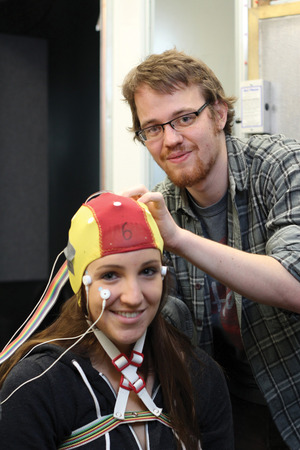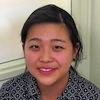The electroencephalography cap—it looks much like a swimmer’s cap— is a fundamental tool for cognitive neuroscience.
The EEG cap fits snugly over the head, allowing the attached electrodes to record the brain’s spontaneous electrical activity. Any number of factors can throw off readings from this highly sensitive equipment, and Dan Klee, a recent graduate of the Clark Honors College, (right) considers every one of them every time he fits a subject with the cap.
The headgear, which can be uncomfortable, must be perfectly positioned, the calibration adjusted precisely for each subject. There is also the human element to consider: Klee must strike a perfect tone with his subjects, calming and defusing those who are apprehensive while projecting the authority necessary to ensure that a test is conducted properly.
It’s the kind of work that typically goes to a graduate student, given the expense of these tests and the demand to get things right the first time. And for Klee, one of precious few undergraduates in cognitive neuroscience entrusted to run these experiments, it’s been thrilling.
“I was game to do it—it was a great opportunity,” Klee said. “The EEG is the meat of the whole cognitive neuroscience process. This was an opportunity to really be doing serious research.”
Klee, in fact, has been game for anything asked of him since joining the laboratory of psychology professor Edward Awh three years ago to study visual working memory and attention.
Klee came to the university expecting to study music. But his real interest was psychology, and the more he studied it the faster he progressed; by sophomore year, he was convinced that he wanted to apply to graduate schools so he began mass-e-mailing professors in the hope of finding a position with a research laboratory. Awh was the first to respond, initiating a three-year relationship during which Klee has enjoyed the latitude to take on whatever interests him in the lab.
Klee studies “visual crowding,” a phenomenon that limits our ability to recognize objects in peripheral vision. Research could bring educational benefits for individuals with attention deficit hyperactivity disorder and the development of learning tools for individuals with specific types of visual impairment.
Undergraduates in Awh’s laboratory start “in the trenches,” the professor said: They learn to develop theories and conduct experiments, recognizing that everything takes longer than the textbooks suggest. Graduate students generally handle data collection but Awh allows talented undergraduates such as Klee to help.
Klee, in fact, is a coauthor for three published papers developed by Awh’s lab, which will only strengthen his application to a PhD program.
His first published paper focused on “subitization,” which is the brain’s ability to instantaneously count, on sight, a number of items; it was published last year in the Journal of Neuroscience. The study incorporated use of the EEG cap; Klee learned the intricacies of the device first by observing a graduate student work with it, then by performing those experiments himself under supervision.
Awh credited Klee not just for his performance in running tests but for being able to join in the higher-level discussion between professors and graduate students about what those tests mean.
“Dan’s one of those students who is able to hold his own in these discussions,” Awh said. “That’s what I’m looking for in a student who wants to be a coauthor and a collaborator at that level. Dan has gone as far as any undergraduate research assistant in my lab for fourteen years.”
—Matt Cooper
photo: Jack Liu




-thumb-200x200-1722-thumb-100x100-1723.jpg)


 From federal forest payments to the benefits of reading readiness, econ honors projects get real.
From federal forest payments to the benefits of reading readiness, econ honors projects get real. SPUR student receives prestigious Howard Hughes Medical Institute Award.
SPUR student receives prestigious Howard Hughes Medical Institute Award.